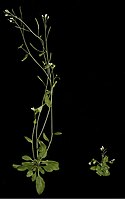
Photo from wikipedia
Plant callus is generally considered to be a mass of undifferentiated cells and can be used for secondary metabolite production, physiological studies, and plant transformation/regeneration. However, there are several types… Click to show full abstract
Plant callus is generally considered to be a mass of undifferentiated cells and can be used for secondary metabolite production, physiological studies, and plant transformation/regeneration. However, there are several types of callus with different morphological and developmental characteristics and not all are suitable for all applications. Callogenesis is a multivariable developmental process affected by several intrinsic and extrinsic factors, but the most important driver is plant growth regulator (PGRs) levels and type. Since callogenesis is a non-linear process influenced by many different factors, robust computational methods such as machine learning algorithms have great potential to model, predict, and optimize callus growth and development. The current study was conducted to evaluate the effect of PGRs on callus morphology in drug-type Cannabis sativa to maximize callus growth and promote embryogenic callus production. For this aim, random forest (RF) and support vector machine (SVM) were applied in conjunction with image processing to model and predict callus morphological and physical traits. The results showed that SVM was more accurate than RF. In order to find the optimal level of PGRs for optimizing callus growth and development, the SVM was linked to a genetic algorithm (GA). To confirm the reliability of SVM-GA, the optimized-predicted outcomes were tested in a validation experiment that revealed SVM-GA was able to accurately model and optimize the system. Moreover, our results showed that there is a significant correlation between embryogenic callus production and the true density of callus. KEY POINTS: • The effect of PGRs on callus growth and development of cannabis was studied. • The predictive accuracy of SVM and RF was evaluated and compared. • GA was linked to the SVM for optimizing the callus growth and development.
Journal Title: Applied microbiology and biotechnology
Year Published: 2021
Link to full text (if available)
Share on Social Media: Sign Up to like & get
recommendations!